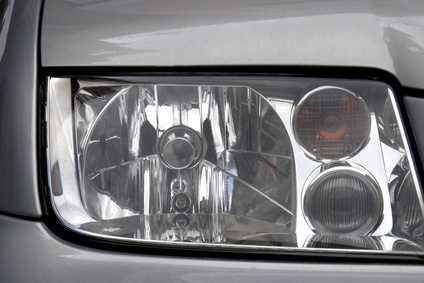
HID lights and HID xenon lights are the same thing. Both employ the inert gas, xenon, as the primary gas that replaces the filament in high intensity discharge light bulbs. Some halogen headlights use xenon for a bluish hue. The distinguishing feature of HID lights is their elimination of the filament necessary in halogen and other traditional light bulbs. This gives HID lights their green advantages: greater illumination, lower power consumption and longer bulb life.
Headlights, more properly called headlamps, were literally lamps in the first cars so equipped. Cadillac created the first widely used electrical system in 1912 by combining the battery's power with headlamp ignition and operation. In 1924, the Bilux bulb introduced low and high beams. The sealed beam headlamp appeared in 1940 and continued to be used until its replacement by higher output halogen lamps in 1962. Halogen lights didn't arrive on the U.S. market until 1978 due to regulations in place that required non-halogen, sealed beam lamps.
In the U.S., Lincoln first introduced HID lights in 1996. HID headlights use "arc-lamp" technology between two electrodes. Higher voltage is required to create the arc, but maintenance of the arc requires far less voltage. The ballast is employed both to provide this voltage regulation and also to keep the voltage from continuously increasing. By encasing the electrodes in glass and adding noble (inert) gases, such as xenon, light output is produced that is three times greater than filament-based lighting.
The color of HID xenon lights differ depending on their color temperature. Color temperature is measured in Kelvins. Kelvins indicate the color temperature of light sources. This is why lights are described as 6,000K or 8,000 kelvin. Daylight is 5,500K, and generally the best visibility at night or in the dark is that which is closest to daylight, or 6,000K. The higher the color temperature goes, the bluer the light source appears.
John Deere has applied HID lights to its tractors. This provides the operator with greatly enhanced nighttime visibility. The heart of the system is the xenon HID bulbs. The HID bulbs provide much greater brightness and a daylight color output for improved definition in the field. The operator sees as much as 250 percent farther ahead, compared with previous tractors. Bulb life is 10 times greater than incandescent bulbs since HID bulbs have no filaments.
Halogen lights generally come in a four-light configuration. By comparison, HID lights only require two bulbs. Today, almost every auto manufacturer offers HID bulbs, and third party vendors sell kits for retrofitting, literally, every type of vehicle. Audi and BMW even include HID xenon headlights in some of their cars as standard equipment as of 2010.